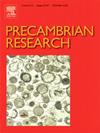Detrital zircon geochronology of the Paleoproterozoic Nonacho Basin (Northwest Territories, Canada): A record of post-collisional collapse amid supercontinent aggregation
IF 3.2
2区 地球科学
Q2 GEOSCIENCES, MULTIDISCIPLINARY
引用次数: 0
Abstract
The study of Paleoproterozoic sedimentary basins is critical to inform aspects of craton development during some of Earth’s earliest supercontinent cycles. The ∼ 1.9 Ga Nonacho Basin is located at the ancestral core of the Canadian Shield near the sutured margins of the Archean Slave and Rae cratons, making it ideal for a detrital zircon study examining evidence of orogenic unroofing during the ca. 1.9 Ga assembly of the supercontinent Nuna. Detrital zircon U–Pb geochronology with chemical-abrasion laser-ablation inductively-coupled plasma mass spectrometry is used to investigate the provenance and maximum depositional ages of the Nonacho Group throughout its alluvial, fluvial and marine deposition. Detritus preserved in the lower stratigraphy (Hjalmar formation) was largely derived locally from the ∼ 2.7–2.3 Ga Nonacho basement complex. The overlying strata (Tronka Chua, Chief Nataway, Newshethdezza, Thekulthili, and Taltson formations) display distinctive age peaks matching the ∼ 2.0–1.9 Ga Thelon and Taltson orogens, together with contributions from varied source areas of the Rae craton. A maximum depositional age at 1887 ± 10 Ma for the Tronka Chua formation indicates that much of the sediment was deposited post ∼ 1.89 Ga, similarly to correlative supracrustal panels of the central Rae craton. This new depositional constraint, together with records of Taltson- and Thelon-derived detritus, corroborate a model whereby the Nonacho Basin evolved in a regime of crustal extension driven by thermal subsidence in the aftermath of the Slave and Rae craton collision, punctuated by crustal flexure as a distant response to the Snowbird orogeny. The Nonacho Group acted as a sink for sediment unroofed from nearby orogenic topography until crustal flexure originating from the Rae-Hearne craton boundary triggered alternate sources, providing an example of how multistage convergence during supercontinent amalgamation controls sediment provenance.
求助全文
约1分钟内获得全文
求助全文
来源期刊

Precambrian Research
地学-地球科学综合
CiteScore
7.20
自引率
28.90%
发文量
325
审稿时长
12 months
期刊介绍:
Precambrian Research publishes studies on all aspects of the early stages of the composition, structure and evolution of the Earth and its planetary neighbours. With a focus on process-oriented and comparative studies, it covers, but is not restricted to, subjects such as:
(1) Chemical, biological, biochemical and cosmochemical evolution; the origin of life; the evolution of the oceans and atmosphere; the early fossil record; palaeobiology;
(2) Geochronology and isotope and elemental geochemistry;
(3) Precambrian mineral deposits;
(4) Geophysical aspects of the early Earth and Precambrian terrains;
(5) Nature, formation and evolution of the Precambrian lithosphere and mantle including magmatic, depositional, metamorphic and tectonic processes.
In addition, the editors particularly welcome integrated process-oriented studies that involve a combination of the above fields and comparative studies that demonstrate the effect of Precambrian evolution on Phanerozoic earth system processes.
Regional and localised studies of Precambrian phenomena are considered appropriate only when the detail and quality allow illustration of a wider process, or when significant gaps in basic knowledge of a particular area can be filled.
 求助内容:
求助内容: 应助结果提醒方式:
应助结果提醒方式:


